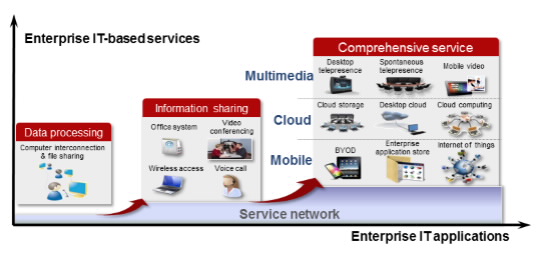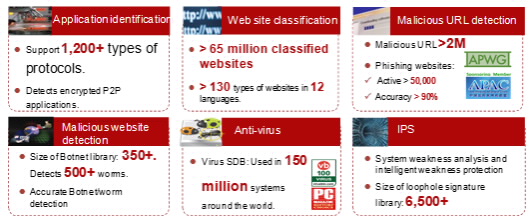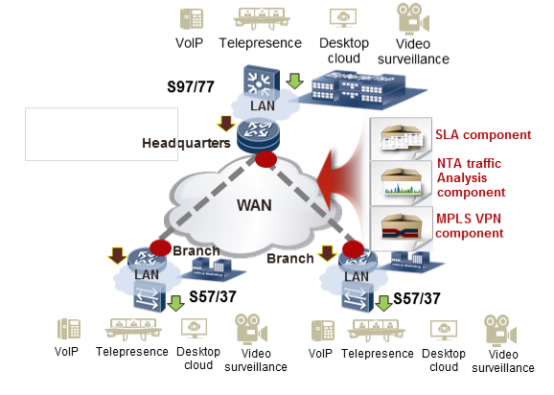As more enterprises deploy enterprise services on IT systems and transmit these services over IP networks, enterprise networks are expanding to support more service types.
Development of enterprise IT applications

Enterprise networks are vital to ensuring service availability; therefore to guarantee uninterrupted services a network must have reliability, security, and maintainability.
Bandwidth demands for enterprise services on network resources continues to increase, especially on Wide Area Network (WAN) bandwidth; however, WAN bandwidth is limited and network resources allocation becomes a crucial decision to ensure reliable user experience of key applications as well as minimize investment.
Enterprise WANs must expand and upgrade to support developing services, meaning WANs must be scalable and able to evolve to ensure service continuity and maximize Return on Investment (ROI).
Huawei launched its Dynamically Optimized WAN solution to solve the challenges of networks’ insufficient bandwidth, poor reliability, security, and maintainability.
Huawei WAN Solution Architecture

Huawei WAN solution’s core characteristics include stable network architecture, highly efficient multi-service provisioning, comprehensive network security, and unified Operation and Maintenance (O&M).
- Stable network architecture – The Huawei WAN solution provides device-level and protocol-level reliability. Self-developed core chips help realize highly efficient and smooth upgrades. IPv6 technologies and the transition solution enable network architecture evolution.
- Dynamically optimized service provisioning – The Huawei WAN solution implements refined Quality of Service (QoS) for multimedia and cloud services to provide differentiated service experience. Various types of load-balancing technologies and WAN-acceleration products can maximize link utilization.
- Comprehensive network security – The Huawei WAN solution provides refined service identification and multi-dimensional policies to provide border security and defend against malicious attacks and unauthorized access.
- Unified O&M – The Huawei WAN solution supports unified management of IP and optical networks and realizes visualized monitoring and O&M of network traffic, providing quality through a simplified and unified Network Management System (NMS).
Stable Network Architecture
The Huawei WAN solution provides a comprehensive collection of enterprise networking products, including optical transmission/Ethernet/WLAN/WAN access routers, aggregation/core routers, network security products, and NMS to realize an end-to-end fundamental network solution.
The Huawei WAN solution provides device-level, network-level, and topology-level network reliability.
Device-level reliability:
- Hardware redundancy design: Dual power supplies, dual Main Processing Units (MPUs), and hot-swappable cards.
- In-Service Software Upgrade (ISSU): Hot patches
- Single-point failure recovery: Non-Stop Forwarding (NSF) and non-stop routing (NSR)
Protocol-level reliability:
- Bidirectional Forwarding Detection (BFD), single hop/multi-hop BFD, and IPv6 BFD.
- Industry-leading quick switchover technologies: IP Fast Reroute (FRR), Label Distribution Protocol (LDP) FRR, and VPN FRR.
Topology-level reliability:
- Dual-plane network
- Double node dual link
- Networks of two carriers

Stable Network Architecture
Dynamically Optimized QoS Guarantee
The Huawei Dynamically Optimized WAN solution offers the following advantages for guaranteeing Quality of Service (QoS):
- Provides various types of service quality assurance to support multiservice provisioning. Hierarchical Quality of Service (HQoS) schedules queues in the physical, logical, and application/service levels using different traffic policies. This provides management for hierarchical traffic and for different types of users and services. Huawei supports five levels of HQoS scheduling, and each DS-TE supports eight CTs, providing a refined End-to-End (E2E) QoS solution.
- Unequal-Cost Multi-Path Routing (UCMP) and load balancing allocate traffic to backup links according to their bandwidth capacities. This realizes more logical use of backup links, eliminating an idle high-bandwidth link and packet loss on the low bandwidth link.
- WAN acceleration products compress traffic based on application characteristics to increase network bandwidth utilization. The WAN acceleration module significantly increases transmission speed and reduces bandwidth requirements by 60 to 70 percent, saving up to 38 percent on costs.

HQoS Realizing Five Levels Scheduling of Interfaces, Sub-Interfaces, User Groups, Users, and Services
Comprehensive Network Security
Huawei’s Dynamically Optimized WAN solution offers the following security protection advantages:
- Provides major security functions, such as anti-virus, Intrusion Prevention System (IPS), URL filtering, IPSec VPN, SSL VPN, GRE VPN, and anti-spam.
- Comprehensive authentication modes and refined service identification realize multi-dimensional policy configuration and execution.
- An advanced traffic management and control solution filters attack and non-service traffic to ensure dynamically optimized service provisioning.

Comprehensive Security
Unified Network Management
Huawei’s Dynamically Optimized WAN solution provides a unified Network Management System (NMS):
- The Huawei U2000 realizes unified management of optical transmission and IP networks.
- Huawei eSight supports the maximum number of third-party devices in the industry. It can manage 675 device types from more than 20 vendors, as well as many types of pre-defined IT and IP devices.
- Supports management of customized devices (alarm, performance, and panel).
- Supports visualized management for telepresence and Multi-Protocol Label Switching (MPLS) VPN to realize end-to-end visualized network quality detection.

Visualized Network Management






